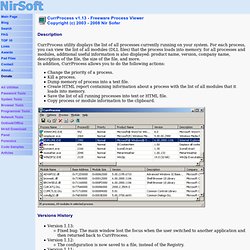

C L Process Viewer/Killer/Suspender. Want a small command line utility to view, kill, suspend or set the priority and affinity of processes, perhaps from a batch file?

. . Has a virus disabled your Task Manager? . . or perhaps your Administrator has? The Command Line Process Utility will function even when the task manager is disabled and/or the dreaded "Task Manager has been disabled by your Administrator" dialog box appears. Works on remote machines with the Microsoft Telnet Server (tlntsvr) found on Windows 2000 and XP or with BeyondExec for Windows NT4/2000/XP. View processes, owners, and CPU time . . Additional switches can be used to display User and Kernel Times (-t) or the Creation Time of processes (-c). Kill Processes . . . Processes can be killed immediately (terminated without saving files or cleaning up) by specifying either the name or the PID (Process IDentifier). If an image name such as iexplore.exe is specified, the utility will kill all processes by that name.
Close Processes . . . Remote Process Viewer. Major Geeks Process Management. XP Process Reviewer Discussion. How-To Geek. If you are familiar with linux/unix, you will be very accustomed to the ability to kill (and start) processes from the command line.

Linux gives you a very rich set of command line tools that simply don’t exist on Windows by default. Enter the Command Line Process Viewer/Killer/Suspender utility from the Beyond Logic website. This is a simple command line utility that lets you perform a number of utilities including viewing a list of processes, killing processes, and even changing the priority of a process. Syntax: process -k “Process ID”process -k “Process Name” Example usage: > process -k “notepad.exe”Command Line Process Viewer/Killer/Suspender for Windows NT/2000/XP V2.03 Copyright(C) 2002-2003 Craig.Peacock@beyondlogic.org Killing PID 2304 ‘notepad.exe’OR:> process -k 2192Command Line Process Viewer/Killer/Suspender for Windows NT/2000/XP V2.03 Copyright(C) 2002-2003 Craig.Peacock@beyondlogic.org Killing PID 2192 ‘notepad.exe’ Process Explorer.
Introduction Ever wondered which program has a particular file or directory open?

Now you can find out. Process Explorer shows you information about which handles and DLLs processes have opened or loaded. The Process Explorer display consists of two sub-windows. The top window always shows a list of the currently active processes, including the names of their owning accounts, whereas the information displayed in the bottom window depends on the mode that Process Explorer is in: if it is in handle mode you'll see the handles that the process selected in the top window has opened; if Process Explorer is in DLL mode you'll see the DLLs and memory-mapped files that the process has loaded.
The unique capabilities of Process Explorer make it useful for tracking down DLL-version problems or handle leaks, and provide insight into the way Windows and applications work. Download Download Process Explorer(1,215 KB) CurrProcess. Description CurrProcess utility displays the list of all processes currently running on your system.

For each process, you can view the list of all modules (DLL files) that the process loads into memory. for all processes and modules, additional useful information is also displayed: product name, version, company name, description of the file, the size of the file, and more. In addition, CurrProcess allows you to do the following actions: Change the priority of a process. Kill a process. Dump memory of process into a text file. Versions History Version 1.13: Fixed bug: The main window lost the focus when the user switched to another application and then returned back to CurrProcess.
System Requirement This utility works properly under Windows 9x, Windows ME, Windows 2000, Windows XP, Windows Server 2003, and Windows Vista. Using The CurrProcess Utility This utility is a standalone executable, so it doesn't require any installation process or additional DLLs.